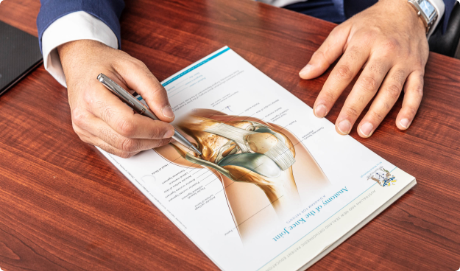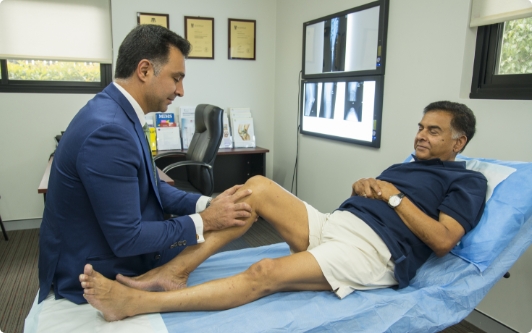Knee Arthritis Conditions
Nearly 1 in 6 Australians suffer from arthritis. The knee joint is the largest joint in the body and one of the most commonly affected joints by arthritis.
What is the anatomy of the knee joint?
The knee joint has 3 compartments:
The medial and lateral tibio-femoral joint compartments; and the patellofemoral joint which can all be affected by knee arthritis.
Who is most at risk of developing knee arthritis and what are the most common causes?
Knee arthritis commonly affects people above the age of 45, with a peak incidence in patients between 60-70 years of age. It is more common in females than males. The commonest causes of arthritis affecting the knee include:

- Osteoarthritis (OA): by far the commonest cause of knee arthritis. It is characterised by progressive wearing away of the cartilage of the joint. As the protective cartilage wears down, the bone ends rub against each other causing knee pain.
- Rheumatoid arthritis: This is an autoimmune disease in which the tissue lining the joint (synovium) becomes inflamed and starts to attack the cartilage surfaces in the knee resulting in a mass of inflamed tissue (pannus) and the production of excessive joint fluid (synovial fluid) causing pain swelling and stiffness.
- Traumatic arthritis: This is a type of arthritis resulting from a knee injury or fracture. Such injuries can occur from work, sports or accidents and cause knee pain, deformity and stiffness over a period of time.
- Gout: this is a condition where uric acid crystals precipitate in the knee causing an inflammatory response leading to cartilage damage.
Book an Appointment Today!

What are the symptoms of knee arthritis (OA)?
- Weight loss.
- Activity modification to avoid any activity that exacerbates the pain.
- Using walking aids such as a walking stick.
- Taking simple analgesics such as paracetamol regularly.
How is knee arthritis diagnosed?
Diagnosis is made after Dr Khatib’s undertakes a clinical assessment including medical history, physical examination and x-rays of the knee. During the physical examination Dr Khatib will examine the affected joint for swelling, tenderness, and range of motion. X-rays of the affected joint may show a loss of the joint space and bone spur formation. There is no blood test for osteoarthritis.
